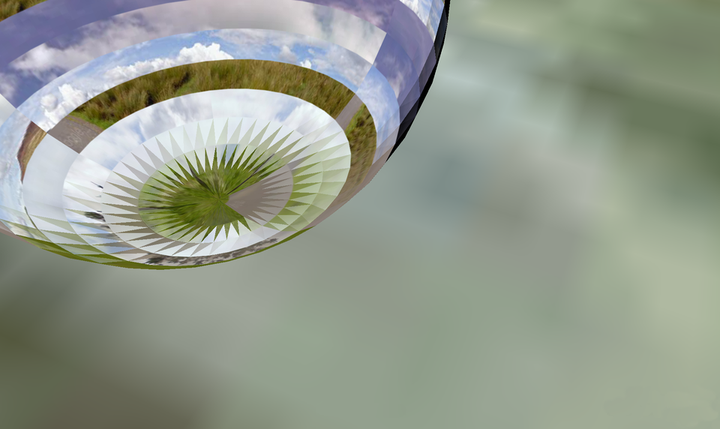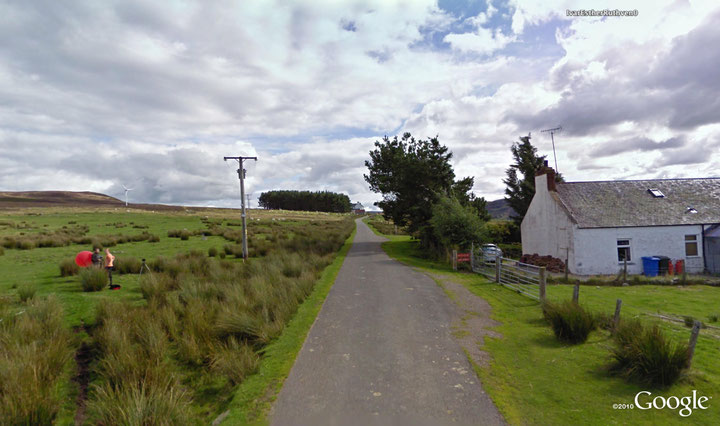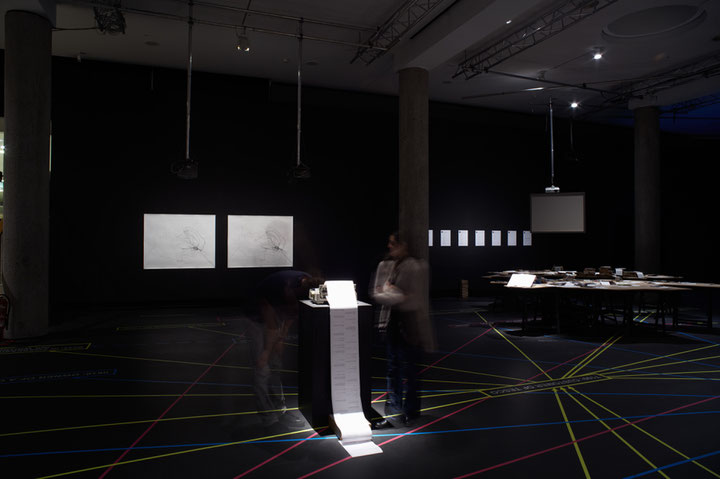Issue 2/2012 - Net section
Between self-positioning and extraneous positioning
Artistic explorations of digital traces – three projects from the exhibition »Tracing Mobility«
The exhibition »Tracing Mobility: Cartography and Migration in Networked Space« evolves out of an observation of the increasing superposition of the virtual and the real world, and addresses ways in which electronic networks and mobile media are altering our perception of time and space, of distance and proximity to an ever greater degree. Presenting 16 positions, the show opens up a wide spectrum of approaches, concentrating however on responding to digital traces. The two artists of plan b, Daniel Belasco Rogers and Sophia New, for example, consider the technical means at their disposal to generate data in order to analyse their own lives. They create a medley of quotidian archives, focused on revealing bygone times and objects.
In the exhibition at the Haus der Kulturen der Welt, plan b’s long-duration performance gradually sketched out the traces of their last five years with a graphite pencil, recapitulating the routes that the artists have traced through Berlin, and which they have been recording with the help of GPS devices since 2007. This generated two personal cartographies with very thick, dark lines marking the routes taken particularly frequently. The mnemonic aspect associated with this is even more acutely apparent in the installation »Narrating Our Lines« (2010), currently showing at Art Laboratory Berlin. A double projection juxtaposes all the GPS traces of the two artists from 2007 in a chronological animation. Indicating the place, date and time, a red or green point moves along the constantly changing pathways. In part the routes are synchronous, whilst at other times even the GPS traces are produced in different places – the green dot for example indicates London, whilst the red dot shows Berlin – or the artists’ actual location is unknown. The juxtaposition offers constant scope to compare, which produces a fascinating dialogue between the two systems of traces. But what are the underlying narratives behind the lines of the two »subject dots«? Belasco Rogers and New reconstructed these narratives in 2010 in a video linked to the piece. Memories of particular moments come back to life in the process, but in many cases this form of mnemonic also turns into an amusing guessing game.
Other data sets deployed by plan b penetrate directly into the realm of communications and feelings in their interpersonal relationship. Throughout the exhibition at the HKW, an ink-jet printer is busy spitting out their mobile text messages from the last five years onto an endless reel of paper. At Art Laboratory, file cards create glimpses into a minimalistic mood diary in the work »Mood Reports 2011«. With all this data it would theoretically be possible to determine which artist sent a particular message on a certain date from a certain location – and their mood on the day in question. So far plan b has explicitly chosen not to make that kind of connection. The works nevertheless also resonate with this perspective, giving us food for thought about the type of data that can be collected and made accessible nowadays.
Status control
Irrespective of the degree to which plan b make their data public in their installations, their mapping procedures are nonetheless accompanied by a desire to manage the data that are generated as they see fit. One example is the mood-reporting programme written for them, which offers the artists considerable scope for data management. Belasco Rogers found the thought of collecting data for a company like Facebook so unappealing that back in 2009 he took the decision to leave the portal.1 He dreams instead of a model in which everyone owns their own data and can license them for others.
Considering Heath Bunting’s »Status Project« however, the trend unfortunately seems to be going in a different direction. Since 2004 Bunting has been examining the ease with which almost all our movements and activities can be recorded. By comparing and combining various data sets, a social status can be ascribed to each individual, generally without their knowledge. Bunting surmises that in the future the readable status of a »virtual identity« will directly determine how much leeway is available to it; in other words, this will determine the an individual’s offline and online mobility. »Status Project« therefore takes as its point of departure an engagement with understanding the »system« from within, in order to use the knowledge gleaned for consciously selected identity mutations, and if necessary constructing the status desired via this strategy. His online database of identity information is now huge, with over 5,000 entries and Bunting repeatedly visualises exemplary portions from it. For »Tracing Mobility« he covered the entire floor of the exhibition space with a network depicting the relationship of a consumer to Tesco, the UK’s largest supermarket chain, in his work »Status Project: located at Tesco« (2011)2. In his view, being part of a corporate chain like this gives an impression of what counts as »being normal«. For the artist this conceals something akin to questionable mass conformity, whose cartographic classification to a certain extent exposes today’s data collection industry and its system of conformist identity formation.
Distorted Street Views
With Street View, an add-on service to the Google Maps cartographic service and the Google Earth geography programme, locations all over the world can be explored in a 360° view at street level. The unauthorised depiction of people and buildings in these images has repeatedly triggered data protection concerns and has led to a number of court trials, a problem that Google in some instances attempts to resolve via pixellation. This topic is given aesthetic expression in »AbstractView« (2009) by Esther Polak and Ivar van Bekkum. A Street View vehicle happened to photograph the artists whilst they were in the Scottish Highlands and shortly afterwards they found themselves on Street View. Polak and van Bekkum were working on a GPS piece with helium balloons when the photo was taken. They can now be seen all over the world with one of these balloons in Street View’s panorama shot. Caught off guard whilst engaged in their artistic work, they decided to react directly with a piece addressing the situation. Appropriating the image in question from the Google service, they deployed it to reflect their own ideas. The outcome of this process is »AbstractView«, a photographic series based solely on found material from Google Earth and Street View. Wonderful balloons now fly over every landscape in which the duo stood, not just their helium balloons, but instead liberated »Street View spheres« too. Up to Version 6 of Google Earth, switching to Street View was depicted with lines of balloon-like digital spheres, which led you via a double click to the familiar panorama images of Street View. These balloons now float in various positions above the landscape, moving wherever the programmed wind blows them. Projected onto this is the panorama shot in which the two artists were originally visible, but now it has been broken up into individual parts, with varying degrees of distortion, arranged in places in a crystalline configuration. »AbstractView« produces an extravagant, rather dream-like view that no longer has anything to do with real-world utilization of Google Street View.
The question of the liberation or domination of the individual by new technologies is of central importance in the projects described here. There is always an ambiguous relationship to commercial network technologies, expressed with greater or lesser vigour, and ultimately coloured by a desire for self-determined access to our digital traces despite the disturbing potential to read data tracks.
www.planbperformance.net/
http://status.irational.org/
www.abstractview.tv
Tracing Mobility: Cartography and Migration in Networked Space, Haus der Kulturen der Welt, Berlin, 24th November to 12th December 2011, www.tracingmobility.org
Navigating the Everyday, plan b: Sophia New & Daniel Belasco Rogers, Art Laboratory Berlin, 27th January to 4th March 2012, http://artlaboratory-berlin.org
Translated by Helen Ferguson
1 http://planbperformance.net/dan/facebook.htm
2 http://status.irational.org/visualisation/maps/A1113_located_at_tesco.pdf




